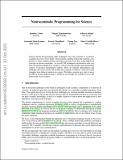Neurosymbolic Programming for Science
| dc.contributor.author | Sun, Jennifer J | |
| dc.contributor.author | Tjandrasuwita, Megan | |
| dc.contributor.author | Sehgal, Atharva | |
| dc.contributor.author | Solar-Lezama, Armando | |
| dc.contributor.author | Chaudhuri, Swarat | |
| dc.contributor.author | Yue, Yisong | |
| dc.contributor.author | Costilla Reyes, Omar | |
| dc.date.accessioned | 2022-10-12T01:58:33Z | |
| dc.date.available | 2022-10-12T01:58:33Z | |
| dc.date.issued | 2022-10-12 | |
| dc.identifier.uri | https://hdl.handle.net/1721.1/145783 | |
| dc.description.abstract | Neurosymbolic Programming (NP) techniques have the potential to accelerate scientific discovery across fields. These models combine neural and symbolic components to learn complex patterns and representations from data, using high-level concepts or known constraints. As a result, NP techniques can interface with symbolic domain knowledge from scientists, such as prior knowledge and experimental context, to produce interpretable outputs. Here, we identify opportunities and challenges between current NP models and scientific workflows, with real-world examples from behavior analysis in science. We define concrete next steps to move the NP for science field forward, to enable its use broadly for workflows across the natural and social sciences. | en_US |
| dc.description.sponsorship | This project was supported by the the National Science Foundation under Grant No. 1918839 "Understanding the World Through Code" http://www.neurosymbolic.org | en_US |
| dc.language.iso | en_US | en_US |
| dc.subject | programming languages | en_US |
| dc.subject | deep learning | en_US |
| dc.subject | science | en_US |
| dc.subject | domain knowledge | en_US |
| dc.title | Neurosymbolic Programming for Science | en_US |
| dc.type | Article | en_US |
